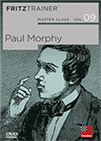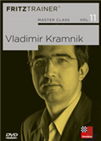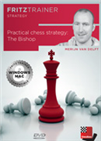What does it take to become a grandmaster?
The coveted grandmaster title is the highest that FIDE awards, aside from “world champion”. The title has a long history. An oft-told story attributed to Frank Marshall is that it originated when Tsar Nicholas of Russia awarded it to the five finalists of the St. Petersburg, 1914 super-tournament. However, chess historian Edward Winter says that this romantic tale is doubtful, evidently emerging only in 1940. The Tsar partly financed the 1914 event but apparently holidayed hundreds of miles away while it ran. Some date the title back to 1838 when a correspondent to the newspaper “Bell’s Life” referred to “our past grand master, Lewis”.
 Learn about one of the greatest geniuses in the history of chess! Paul Morphy's career (1837-1884) lasted only a few years and yet he managed to defeat the best chess players of his time.
Learn about one of the greatest geniuses in the history of chess! Paul Morphy's career (1837-1884) lasted only a few years and yet he managed to defeat the best chess players of his time.For many decades, the title was informal. A few apex players, perhaps the top 10 or 20, more- or- less by consensus were dubbed international grandmasters. In 1950 FIDE made the title official, formally bestowing it on 27 living players. For two decades thereafter, FIDE sporadically awarded it according to various criteria, such as qualifying for the Candidates series.
In 1970, FIDE adopted the Elo rating system and introduced and later tinkered with various new qualifying criteria, such as winning the world junior or senior championship or achieving a rating of 2500 and several title ‘norms’, The grandmaster title nominally is held for life, but three have been retracted.
FIDE also introduced “honorary” grandmaster titles for players perhaps too far past their prime to meet the new criteria but who once had played at top level. Wikipedia says that 31 were awarded from 1977 to 2003.
Some say that the grandmaster title has been devalued over the decades, becoming too easy to get. They cite large numbers of grandmasters, far beyond the 10 or 20 before 1950 and they cite rating inflation at the top. In 1971, only Robert Fischer was rated over 2700 (at 2740) but the October 2020 list has 38 players over 2700 and three over 2800. But on the other hand, there are so many more internationally-rated players and tournaments and rating list entry now is easy. Furthermore, some evidence from computer analysis of games suggests that top players today actually have become stronger.
What are the grandmaster trends since the first FIDE rating list? I have taken some data from Wikipedia’s grandmaster list in early 2020 but mostly rely on a database which compiles all FIDE rating lists to February 2020. FIDE lists themselves sometimes have problems and all data below are approximations. Finally, I look at the perennial question of what it takes to become a grandmaster.
Demographic trends
How many grandmasters are there? Getting an exact count is difficult. The October 2020 FIDE rating list has 1722 but excludes deceased players. Wikipedia lists all grandmasters from 1950 and their title award dates, with data evidently taken mostly from title applications and rating lists. The Wikipedia count from 1950 to 2019 (the last full year), including 31 honorary ones since 1970, is 1888 and from 1972 to 2019 is 1781.
What is the trend in title awards by year? Figure 1 presents the Wikipedia count each year from 1950 to 2019. Annual awards vary greatly but the overall trend is up from 1972.

Figure 1

Figure 2
I compiled my own count from rating lists. I took the date of title award from the first appearance of “g” or “GM” against a player’s name in the list’s title field, disregarded honorary ones, and cross-checked my own list with Wikipedia’s. The latter sometimes says that the title was awarded in one year while “GM” appeared in the list title field in the next year, often because of a lag between meeting requirements and getting the award. Some players were awarded the title long before first appearing on the rating list. For example, former world champion Max Euwe received the title in 1950 but was rated only in 1974. There are a few other discrepancies, with Wikipedia stating a title was awarded but no indication appearing in the title field. The FIDE lists themselves are not completely reliable. I have used only apparent new awards from 1972.
The first FIDE list had 82 grandmasters. Counting new awards only from 1972, my total to February 2020 is 1751, about the same as Wikipedia’s count without the honorary titles. Figure 2 shows my yearly count from when “g” or “GM” appears in the title field. The overall trend is upwards, from just one new award in 1974 to 85 in 2007.
Almost all grandmasters are male but a major trend since the 1970s is more females. The first was Nona Gaprindashvili in 1978 and there are 37 in October, 2020.
Table 1 shows that the median age of gaining the title, from the FIDE lists, is about 25 years old, with a huge range from 12 to 66 years.
Table 1
Title statistics for all new awards from 1972. Games- to- title values are based only on players on the list from July 1985 when FIDE first reports game numbers.
| |
Median |
Lowest |
Highest |
| Age at title |
25.13 |
12.86* |
66.18 |
| Years to title from list entry |
9.01 |
0 |
40.53 |
| Rated games to title |
512 |
30 |
2291 |
*Based on when “GM” first appears in the title field. Sergey Karjakin met title requirements at age 12 years and 7 months.
Figure 3 shows that the median age of gaining the title has steadily dropped by about four years from 1972, perhaps partly the list is much easier to enter. Robert Fischer’s 1958 record of 15 years old stood until 1991 when Judit Polgar beat it by a month or so. Nowadays, there are more 13 year old grandmasters but Sergey Karjakin’s record 12 years and 7 months has held since 2002.

Figure 3
Table 2 shows the top ten nationalities of the 1751 grandmasters. Russia dominates the count, as did its predecessor the Soviet Union (with 30 of the 82 grandmaster titles on the 1970 list). Then follow Ukraine and the United States on equal second. China and India have risen in the ranking. Both nations gained their first grandmaster only in the late 1980s.
Table 2
 This DVD allows you to learn from the example of one of the best players in the history of chess and from the explanations of the authors (Pelletier, Marin, Müller and Reeh) how to successfully organise your games strategically, consequently how to keep y
This DVD allows you to learn from the example of one of the best players in the history of chess and from the explanations of the authors (Pelletier, Marin, Müller and Reeh) how to successfully organise your games strategically, consequently how to keep yTop ten nations for grandmasters based on 1751 title awards from 1972 to February, 2020.
| Nation |
Title count |
| Russia |
252 |
| Ukraine |
94 |
| USA |
94 |
| Germany |
90 |
| India |
64 |
| Spain |
57 |
| Hungary |
54 |
| Serbia |
53 |
| France |
50 |
| China |
48 |
Other title trends
Table 1 shows that the median years from list entry to gaining the title is about nine years, again with a huge range. Figure 4 shows that the median number of years to gain the title has risen steadily from 1972, perhaps because it is much easier to enter the FIDE list.

Figure 4
FIDE reports game numbers in a rating period only from July 1985 and the data about games- to-title refer to those first on the list from that date with the first title award only in 1988. The median is 512 games, again with a huge range. Figure 5 shows that median number of games to title has steadily risen.

Figure 5
Grandmaster learning curves and career paths
As noted, the average rating for top ten players has risen since 1970, but has that for all grandmasters? I looked at ratings of the 1751 grandmasters only after GM appeared in their title field, disregarding ratings before they gained the title.
Figure 6 presents the average rating in the first list each year from 1972 to 2020. Although the sample size varies greatly over the years, the mean grandmaster rating has remained roughly constant at about 2500. The vertical error bars in Figure 6 show the standard deviation each year, a measure of the variation. About 68% of the ratings fall within the bars, so the variation has risen.

Figure 6
What does the typical grandmaster learning curve from list entry look like? All skill learning curves tend to follow a similar pattern. Most improvement happens early on and then the rate of improvement progressively declines and then performance plateaus. Most players plateau after about 750 FIDE-rated games.
To give a long forward span, I took a sample of all grandmasters first on the list between July 1985 and July 1995 who were under age 20 at list entry, and who played at least 1000 FIDE-rated games. There were 299 players. I averaged ratings in approximate 50 game categories; from 0-49 games to over 1000-1049. Figure 7 shows the mean curve for all 299. It follows the classic pattern almost perfectly with a plateau after around 800 games.

Figure 7
In other studies, I have taken the learning curve out much further; past an astronomical 4000 FIDE-rated games. The typical pattern is a rise to a plateau, a lengthy spell at that plateau and an eventual slow decline.
What is the activity pattern over age? Grandmasters can become inactive for various reasons, from poor health to lack of interest to developing other interests to needing to make a better living. Only the very top players make a decent income from chess. But it is interesting to look at the activity patterns for very active players over age. I took a sample of 126 players who entered the domain from July 1985 at age 18 or less and still were active at over age 40. I deleted game counts at age 18 and 45 which might not have been complete years. Figure 8 shows the median game counts by year from age 19 to 44. The peak activity age is 28 and then game counts steadily decline. However, note that this sample consists only of very active players. Others play a few hundred games only and then play few or none.

Figure 8
Can almost anyone become a grandmaster?
 When it comes to strategy, one of the key things that chess professionals understand much better than amateur players is the role of the bishop which is the key theme on this video course.
When it comes to strategy, one of the key things that chess professionals understand much better than amateur players is the role of the bishop which is the key theme on this video course.And finally, what does it take to become a grandmaster? Can it be almost anyone with enough willpower as U.S. president Calvin Coolidge argued, “Nothing in the world can take the place of persistence… Persistence and determination alone are omnipotent”. Or does it require much natural talent, including a high IQ score, and extensive practice?
A view once prevailed that natural talent is non-existent or unimportant, that only extensive and the right kind of practice and study are key. Top performers in any area just get an early start and much practice. The celebrated Polgar sisters case often was cited as supporting evidence for this view, two sisters becoming grandmasters and the third an international master.
Unfortunately this fair, democratic, appealing practice-alone-is-enough view largely has been discredited. Given their background, all three Polgar sisters probably have much natural talent for chess.
Almost certainly, a potential grandmaster needs both natural talent and extensive practice, particularly playing many rated games. There is a good correlation between number of games and years needed to gain the title and age of gaining the title which, when analysed statistically, points to a potent natural talent factor.
As Table 1 shows, persistence also is needed for those with some but not an abundance of talent. I found that about one third of all players who entered the list from July 1985 and who had played at least 750 rated games became grandmasters and about another third became international masters. But it is not enough just to play 750 games! Those who do so probably have talent because we tend to like and persist at what we are good and successful at. Those with little talent usually never start or soon drop out after repeated failures. If I wanted to be a champion boxer but just kept getting knocked out in the first round despite extensive training, soon I would abandon the sport.
What does natural talent for chess consist of? Probably needed is a high but not astronomical IQ score, one perhaps in the top 10% or 20% of the general population. The German newsmagazine “Der Spiegel” gave then world champion Garry Kasparov two standard IQ tests and he scored just over 120 on one and 135 on the other. Other needed traits probably are a good memory to store a huge amount of chess knowledge, ability to visualize well for chess calculation, and physical stamina and high competitiveness.
If almost anyone could become a grandmaster, there surely would be many more. Nevertheless, doubtless there also is some unrealized potential; players who could have achieved the title but dropped out for various reasons or never started. And, if grandmasters were paid like major league baseball players, certainly there would be some more.
Bibliography
- Howard, R.W. (2020). Mapping the outer reaches of the learning curve. Acta Psychologica, 209.
- Regan, K. W. & Haworth, G. M. (2011). Intrinsic chess ratings. In Proceedings of the 25th AAAI conference on artificial intelligence (pp. 834– 839). Palo Alto, CA: AAAI Press.
- Vaci, N., Edelsbrunner, P., Stern, E., Neubauer, A., Bilalic, M., & Grabner, R. H. (2019). The joint influence of intelligence and practice on skill development throughout the life span. Proceedings of the National Academy of Sciences, 116, 18363-18369.
- Wikipedia. Entry for “Grandmaster (chess).” Accessed February, 2020.
Links
.jpeg)






























